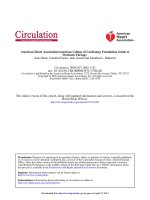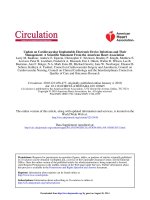pham gia khai khotailieu y hoc
Bạn đang xem bản rút gọn của tài liệu. Xem và tải ngay bản đầy đủ của tài liệu tại đây (4 MB, 57 trang )
Hypertension in Patients with
Coronary Artery Disease
Prof. Pham Gia Khai, MD. PhD. FACC. FESC
Conflict of interest
•
Nil
Case
• 61 yrs. F.
• HTN: 10 yrs: well controlled for 5 yrs; recent 5
yrs. Not well controlled
• DM: 5 yrs. Rx: SU + Metformin
• Atypical chest pain
• Dyspnea on exertion
• ECG: LV hypertrophy; cannot rule out CAD
• Cardiac Echo: LVDd: 57 mm; EF: 45%
MCQ (slide 4)
•
•
•
•
•
•
•
•
•
•
•
•
•
•
Diagnosis of Hypertension :
(A) Systolic ≥ 140 mmHg or
Diastolic ≥ 90 mmHg
(B) Systolic ≥ 140 mmHg and
Choose the right answer
Diastolic ≥ 90 mmHg
Diagnosis of Diabetes mellitus
(A) Fasting Blood Glucose ≥ 7 mmol/L (≥ 126 mg/L) and/or HbA1C ≥ 6.5
(B) Fasting Blood Glucose ≥ 7 mmol/L and 2hr post-prandial Blood Glucose ≥ 7.8
mmol/L (C) Both (A) and (B) Choose the right answer
Diagnosis of coronary heart disease
(A) Chest pain relieved by Nitrates, cardiac enzymes normal
(B) Chest pain not relieved by Nitrates, cardiac enzymes normal
(C) Suggestive coronary angiogram, cardiac enzymes normal
(D) Elevated cardiac enzymes, but coronary angiogram normal
Choose the right answer
ECG
Questions ???
• Relationship between HTN and CAD
• What is the difference of CAD profile in HTN
vs normotensive patients?
• Pretest possibility of CAD? %?
• Which is the best test for diagnosis of CAD in
this patients?
• Optimal strategy for CAD pts with HTN?
BP levels are directly related to ischemic heart
disease at any decade of age
128
64
Age at risk:
80–89 years
70–79 years
60–69 years
32
16
256
50–59 years
8
4
2
IHD mortality
(floating absolute risk and 95% CI)
IHD mortality
(floating absolute risk and 95% CI)
256
128
64
80–89 years
70–79 years
60–69 years
32
16
50–59 years
8
4
2
1
1
0
0
120 140 160 180
Usual SBP (mmHg)
Age at risk:
70
Usual DBP (mmHg) 80
90
Lewington et al. Lancet 2002;360:1903–13
Incidence of MI and total stroke by systolic BP
strata in the in the Framingham population
D’Agostino RW, et al. BMJ 1991; 303:385-389
Intensive Lowering BP levels increases risk of MI
in patients at high or very high CV risk
Incidence of primary outcome, %
Mortality increases with follow-up DBP < 70 mmHg
in the INVEST trial
60
50
40
30
20
10
0
60
> 60 to 70
> 70 to 80
> 80 to 90
> 90 to 100 > 100 to 110
> 110
Diastolic Blood Pressure, mmHg
Patientswith
primaryoutcome,n
56
389
176
2239
Patientswith
primaryoutcome
124.3
131.7
Patientswithout
primaryoutcome
127.0
129.1
Totalpatients,n
1003
596
174
33
17
7376
1230
202
46
135.1
143.7
160.2
171.6
186.0
131.0
138.8
154.2
169.4
187.5
11306
Meansystolicbloodpressure,mmHg
.
100 % had coronary heart disease; treatment with beta blocker or calcium channel blocker
Messerli et al. Ann Intern Med 2006;144:884–893
30
3
25
2.5
20
2
15
1.5
10
1
5
0.5
0
0
112
121
126
130
133
136
140
143
149
Hazard ratio, 95 % confidence intervals
Adjusted 4.5-year risk of events, %
Cardiovascular mortality increases with follow-up SBP
< 120 mmHg in the ONTARGET trial
160
75 % had coronary heart disease at baseline treatment with ACEi and/or ARB.
Sleight et al J. Hypertens 2009;27:1360–1369
ACCORD-BPLA Trial
Intensive Lowering of BP levels did not improve CAD
outcomes in the diabetic patients
Cusham W, et al. N Engl J Med 2010;362:1575-85
ROADMAP: Lowest SBP and/or highest SBP reduction
quartile are associated with increased
CV mortality in patients with CHD
Last SBP before event
mmHg
Cohort of patients with pre-existing CHD (n=1104)
*
26-MAY-2010
SBP reduction
mmHg
ROADMAP: The increased mortality was only seen in
patients with pre-existing cardiovascular disease (CVD)
Cardiovasular mortality (%)
Olmesartan
26-MA0
Placebo
p = 0.02
INVEST Trial
Incidence of MI and Stroke
in Hypertensive patients with CAD
stratified by Diastolic Blood Pressure levels
Messerli, et al. Ann Intern Med 2006;144:884–893
The Diagnostic dilemma of CAD in hypertensive
patients
• Chest pain is a common but also non-specific symptom in
hypertensive patients both with and without CAD.
• Non invasive screening tests are not able to accurately
discriminate between hypertensive patients with and without
associated CAD.
• International guidelines are elusive on the recommended
diagnostic pathway for detection of CAD in this group of
patients.
• Early CV risk stratification and evaluation of markers of organ
damage may improve diagnostic efficacy.
Chin D, Battistoni A, Tocci G, Passerini J, Parati G, Volpe M. Am J Hypertens. 2012 ; 25:1226-35
.
Exercise ECG
• Exercise ECG tests have a low specificity and sensitivity for
CAD determination, especially in hypertensive patients.
• This group of patients often have baseline ECG changes,
especially in patients with LVH.
Chin D, Battistoni A, Tocci G, Passerini J, Parati G, Volpe M. Am J Hypertens. 2012;25: 1226-35.
Exercise ECG
Weaknesses:
•
Suboptimal sensitivity.
•
Low sensitivity in identifying single vessel disease.
•
the test is not diagnostic in situations where there are
baseline ECG changes (such as evidence of left
ventricular strain secondary
to left ventricular
hypertrophy, left bundle branch block).
•
Low specificity in certain population of patients (such as
pre-menopausal women).
•
To increase the accuracy of the test it is necessary to
achieve 85% of the maximum heart rate.
Exercise ECG
Weaknesses:
•
Suboptimal sensitivity.
•
Low sensitivity in identifying single vessel disease.
•
the test is not diagnostic in situations where there are
baseline ECG changes (such as evidence of left
ventricular strain secondary
to left ventricular
hypertrophy, left bundle branch block).
•
Low specificity in certain population of patients (such as
pre-menopausal women).
•
To increase the accuracy of the test it is necessary to
achieve 85% of the maximum heart rate.
Stress echocardiography
Strengths:
• higher sensitivity and specificity than the exrecise ECG test.
• it has a higher prognostic value compared to the exercise ECG
(in fact even in the presence of a positive exercise ECG test, a
negative stress echocardiogram predicts a low risk for coronary
events).
•Higher sensitivity during exercise or with dobutamine, compared
to using other vasodilating agents.
•It enables assessment of other concomitant structural cardiac
abnormalities, such as valvular heart disease.
•Lack of radiation.
Chin D, Battistoni A, Tocci G, Passerini J, Parati G, Volpe M. Am J
Hypertens. 2012;25: 1226-35.
Weaknesses:
• lower sensitivity in identifying one vessel disease or
moderate stenosis.
• the inability to visualise the entire left ventricle in a
single window in certain patient groups.
•the assessment of the images is operator-dependent.
• it is mainly a qualitative, rather than a quantitative
assessment.
• an inadequate acoustic window in certain patient groups
limits the sensitivity and specificity of the test (such as
Chronic obstructive pulmonary disease patients)
Chin D, Battistoni A, Tocci G, Passerini J, Parati G, Volpe M. Am J Hypertens. 2012;25: 1226-35.
SPECT
Strengths:
Quantitative method, which reduces operator bias
and inter-observer variability.
New nuclear techniques such as the “gated” SPECT,
l
enable a contemporary functional and perfusional
assessment of the myocardium, hence increasing the
specificity of the diagnosis of coronaropathy.
Weaknesses:
•
l
l
Poor spatial resolution ( approx. 1cm).
The need to use radioactive material limits the use
of this diagnostic technique as a regular “screening”
test in hypertensive patients.
Chin D, Battistoni A, Tocci G, Passerini J, Parati G, Volpe M. Am J
Hypertens. 2012;25: 1226-35.
Coronary angiography
remains the
“Gold Standard” ???
Coronary angiography in HT
- In patients without known CAD undergoing elective
invasive angiography the diagnostic yield is relatively low
- This is particularly true for HT with LVH.
- CV risk profiling in HT is of clinical value
Patel MR et al ,
NEJM 2010
The majority of patients with Hypertension
have other coronary risk factors
Framingham Study
Kannel, Am J Hypertens, 2000; 13: 3S-10S









